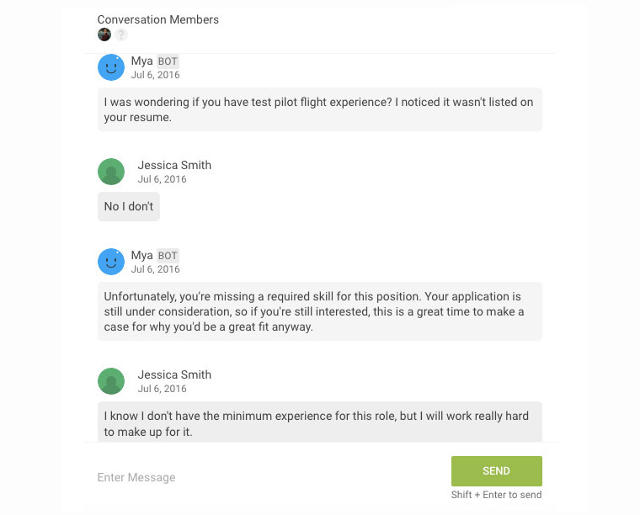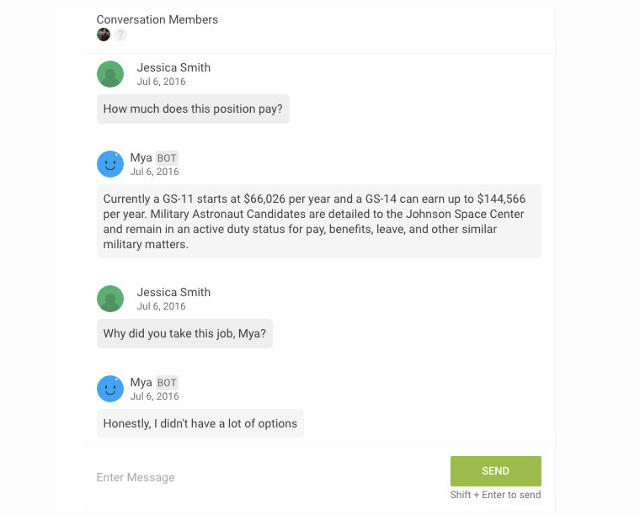This ChatBot Can Make Sure Your Resume Won’t End Up In A Black Hole
Eyal Grayevsky talks a lot about black holes, but he’s not referring to the ones in outer space.
The cofounder and CEO of FirstJob, an HR technology company, means the place where job applications go. One survey found that 75% of workers never heard back from a potential employer after applying.
That hole turns into a vortex, according to Grayevsky, when candidates start applying to any job they’re remotely qualified for. “It becomes a numbers game,” he says. The result: candidates who are not engaged and recruiters who aren’t getting the higher-quality talent they seek.
To end this vicious cycle, Grayevsky and his team created Mya. The artificially intelligent recruiting assistant is a chatbot that communicates directly with applicants looking for tech jobs via text, email, or through its own chat platform. It launches today out of 10-month private beta.
Grayevsky says Mya is a natural outgrowth of FirstJob’s efforts to connect qualified candidates with recruiters. By automating up to 75% of the application process, recruiters are able to cut down on the time spent reviewing what Grayevsky estimates to be “tens of thousands” of applications, and more time conducting interviews and making offers. For candidates chatting with Mya, their conversations are logged and followed up on. Mya sends them updates, offers guidance to candidates, and alerts them if the job has been filled.
The way it works is straightforward.
Job seekers log in to the platform and view available jobs. They select from open positions that have detailed descriptions as well as keywords corresponding to skills required. After filling out a short application (name, address, etc.) Mya (depicted by a blue smiley face avatar) introduces herself and says she’d like to ask some additional questions. “It should only take about 15 minutes and will improve your chances of getting hired,” she writes.

Based on the candidate’s qualifications and the job requirements, Mya asks for more detailed information about experience. “How much experience do you have with MySQL database?” for example. The applicant then has a chance to expand on their qualifications as well as ask any questions they might have for the employer.
Mya is able to pinpoint skills that the candidate might be missing and asks them to make a case why they should still be considered for the job, This, says Grayevsky, gives the job seeker an opportunity to showcase their strengths much the way they would in an in-person interview.
As Grayevsky walked me through a hypothetical demonstration of this process, he showed how Mya could interact on other levels. He asked if he could bring his dog Fluffy to work if he was hired for a fictitious position at NASA. Mya replied with, “Sorry, but pets are currently not allowed at the Johnson Space Center.” She is also able to answer other questions about the potential employer, such as workplace hours and other company policies, culture, benefits, and the hiring process. Her responses draw from the most frequently asked questions provided by the organization.

AI chatbots get smarter with use, and Mya is no exception, says Grayevsky. If she doesn’t know the answer to a question, she responds with an “I’ll find out and get back to you.” Participating recruiters have access to a dashboard that gathers this and data collected by Mya’s interaction with the applicant and serves up an analysis. Candidates are organized by what stage of the application process they are in. They are also ranked by fit (meets requirements, overqualified, strong, underqualified). Their engagement level with Mya is accounted for as well, ranking from very low to average, high, or very high.
The platform lets recruiters check off which applicants will move to the next phase and which didn’t make the cut, either individually, or in batches. Those who aren’t a fit will be notified by Mya. Each employer drafts a version of their rejection letter, which can include a reference to what their application was lacking.
It gets a bit tricky here, because employers aren’t always able to be very specific due to legal constraints, Grayevsky acknowledges. A recent study from the Talent Board, a nonprofit that studies recruiting practices, indicates that out of more than 2,000 respondents, only 4.4% got specific feedback from hiring managers and recruiters.
Employers can create a custom dialogue, he says. It’s also an opportunity to frame a disqualification based on a lack of skills into a positive interaction for the candidate, he says, such as directing them to other open positions.

The platform is free for job seekers. Companies pay prices based on the number of candidates they process per month. Parent company FirstJob currently has 11 million active millennial job seekers and companies such as Zappos, Quicken Loans, Tesla, ADP, Ricoh, Goodyear, Fiat Chrysler, and NetSuite subscribe to use its service. This part of the company is profitable, according to Grayevsky.
He wouldn’t discuss specific user numbers or conversions from applicant to hire for Mya, because he says the data sets are still being finalized. What he does share is that Mya has improved recruiter efficiency by 38% and increases candidate engagement by over 150%. He says that the most important finding is that candidates are three times more likely to hear back from a recruiter if they respond to Mya’s questions. “That means Mya is giving candidates, who were traditionally overlooked due to inefficiencies in the job market, more control of their outcome.”
The use of artificial intelligence and automation in recruiting has come under fire recently. Writing for PBS Newshour, veteran tech recruiter Nick Corcodilos opines on the myth of the skills gap. We’ve reported on the fact that managers find college graduates lacking in communication and critical thinking skills, but have tech skills aplenty. Corcodilos faults AI for breeding indifference among talented job seekers. He writes:
In a job seeker’s market, new grads must subject themselves to machine interviews, invest their time filling out online applications, and wait like starving dogs to be fed. Meanwhile, Goldman Sachs HR managers get paid to wait for someone else to do their hiring.
Corcodilos believes that during such a “shortage,” recruiters must go out and sell to candidates. “It requires personal contact, persuasion and, yes, a soft touch.”
He may not have had the opportunity to interact with Mya, who has been programmed to have a little fun with applicants, too. For example, Grayevsky asked her why she took her job. “Honestly, I didn’t have a lot of options,” she writes. In case there’s a zombie apocalypse, Mya quotes Sean of the Dead, saying she plans to “head down the pub, grab a pint, and wait for it to blow over.”
Related Video: 3 Resume myths you shouldn’t believe
Fast Company , Read Full Story
(47)














